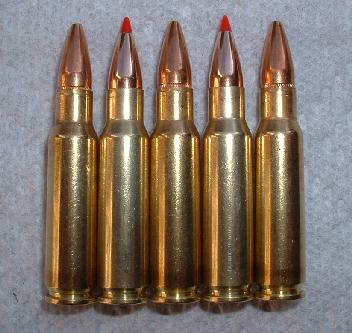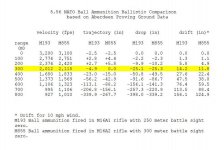I have done a lot of research on various firearm cartridges and read a few things about the 5.56x45 NATO. The United States military swapped the 7.62 NATO for the 5.56 NATO in the 60s due to the fact that it produced less recoil and was lighter so more rounds per soldier could be carried. However I have been reading a few articles and listening to some people in the military and the 5.56mm although accurate has some problems with stopping power... I have heard many stories of US troops complaining about the stopping power of the 5.56mm round but due largely to good marksmenship of NATO troops any weakness of the 5.56mm in stopping power if voided if you get a head/heart shot. However I have been reading and hearing complaints of insurgents being hit by the 5.56mm and not going down.
However the 7.62x39 Soviet that that AK-47 fires is much more damaging due to it being both larger and slower. It is also a much better at cutting through body armor the 5.45mm aka 'poison bullt' is basically the same story. Although the the 7.62mm is slower and less accurate at long ranges it still does more damage than the 5.56mm.
Yes I know the 5.56mm can create some nasty wounds when it tumbles or fragments and I am not saying I would wanna get hit with one, but I would much rather get hit with it than the 7.62mm Soviet. US military officals came out and said that the 5.56mm was designed to wound rather than kill its target for two reasons:
1. you might wanna ask the guy some questions
2. ties up more troops to carry him way to get medical attention
Although that all said and good it is possible for a wounded enemy to fire his AK and kill you. the gap and design trade off between the two rounds (5.56mm vs 7.62mm) has sparked a debate has been going on for a long time. However work began to close that gab and create a round that gave the soldier in question accuracy and stopping power thus solving the problem and allowing everyone to move on to another topic.
Say hello to the 6.8mm Remington SPC and 6.5mm Grendel
6.8mm Remington SPC

6.5mm Grendel

Both rounds are accurate and deadly. Which one do you think it should be? Me personally I think I will go with the Grendel.
However the 7.62x39 Soviet that that AK-47 fires is much more damaging due to it being both larger and slower. It is also a much better at cutting through body armor the 5.45mm aka 'poison bullt' is basically the same story. Although the the 7.62mm is slower and less accurate at long ranges it still does more damage than the 5.56mm.
Yes I know the 5.56mm can create some nasty wounds when it tumbles or fragments and I am not saying I would wanna get hit with one, but I would much rather get hit with it than the 7.62mm Soviet. US military officals came out and said that the 5.56mm was designed to wound rather than kill its target for two reasons:
1. you might wanna ask the guy some questions
2. ties up more troops to carry him way to get medical attention
Although that all said and good it is possible for a wounded enemy to fire his AK and kill you. the gap and design trade off between the two rounds (5.56mm vs 7.62mm) has sparked a debate has been going on for a long time. However work began to close that gab and create a round that gave the soldier in question accuracy and stopping power thus solving the problem and allowing everyone to move on to another topic.
Say hello to the 6.8mm Remington SPC and 6.5mm Grendel
6.8mm Remington SPC

6.5mm Grendel

Both rounds are accurate and deadly. Which one do you think it should be? Me personally I think I will go with the Grendel.



